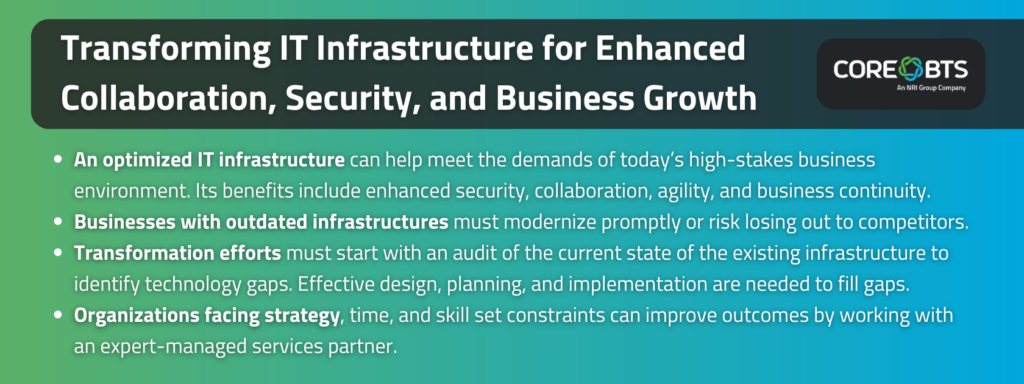As a business expands, there's a corresponding need to improve the IT environment and address increasing cybersecurity threats to stay competitive.

Business and IT leaders increasingly lead digital transformation initiatives to drive growth and profitability. According to Gartner, global IT spending will reach $5 trillion in 2024, representing a 6.8% year-over-year increase.
However, significant challenges remain. For example, determining the best IT infrastructure optimization strategy for better security, collaboration, business growth, and continuity is a major sticking point. Many organizations’ internal resources also lack the technology integration and implementation skills to drive modernization efforts. The talent gap affects these initiatives, as does a lack of urgency and robust strategy.
There is a risk in not moving quickly to secure your business's future. Fast-acting competitors may overcome challenges and realize their digital transformation objectives ahead of you. Taking a proactive approach to IT transformation infrastructure is paramount.
Keeping Pace With Modern Computing Environments
These steps can eliminate hiccups in IT infrastructure transformation:
1. Assess the Current State
Businesses must take a fresh look at their digital initiatives and set the right tone to accelerate transformation. That starts with examining whether and how the IT infrastructure enables the business to do the following:
- Modernize by adopting new technologies. Artificial intelligence (AI), machine learning (ML), the Internet of Things (IoT), robotic process automation (RPA), and other emerging technologies require a solid, flexible infrastructure.
- Pivot to new work and operation models as needed. The hybrid workplace and changing market and customer demands require business agility.
- Leverage cloud services like Microsoft Azure to achieve improved business outcomes such as speed to market, cost optimization, efficiency, and security.
Put differently, does your IT infrastructure allow for easy cloud migration? Does it allow for easy integration to speed up decision-making? Do internal resources have automated platforms and processes to streamline operations?
During the audit, businesses must also evaluate whether internal teams have the skills and capacity to handle the transformation project. If significant constraints exist, the business can enlist the services of an external partner.
2. Design a Robust Framework
Next, businesses must develop an IT infrastructure framework to prioritize key initiatives using requirements and information gathered during the assessment phase. From there, key stakeholders must review, discuss, revise, and finalize the framework before planning.
3. Develop a Strategic Optimization Plan
During planning, businesses decide how to carry out infrastructure optimization. They develop solid plans, a detailed roadmap, and reasonable timelines for implementing the prioritized initiatives. At this stage, objectives are defined and validated against financial, time, technology, and human resource constraints.
4. Meticulously Execute the Plan
Next, businesses move to the implementation phase. They apply the optimization approach to the IT infrastructure based on the established framework, plans, and roadmap.
Benefits of IT Infrastructure Optimization
An outdated and sub-optimal infrastructure negatively impacts your business's security and growth. Switching to a modern, optimized one lets you reap these benefits:
- Enhanced security: You’ll effectively protect all network traffic, improve threat detection/response, decrease the attack surface, and mitigate cyber risk with cutting-edge security tools.
- Better collaboration: You’ll improve cross-functional collaboration by eliminating silos in your IT environment. For example, a strategically implemented hybrid cloud infrastructure increases compatibility across systems and applications, simplifies procedures, and improves data management, making it easy for teams and departments to work together.
- Business continuity: You’ll avoid data loss and business disruption during downtime, outages, breakdowns, and natural disasters with robust backup and recovery solutions. As a result, you’ll continue upholding commitments to stakeholders and customers with confidence.
- Increased business agility: You'll scale enterprise offerings, expand to new markets, and increase workloads on demand without significant costs or hurdles. Whether you need to scale vertically by adding storage space and computing resources or horizontally by automating processes, an optimized infrastructure makes the job easy.
When faced with the prospect of IT infrastructure optimization, businesses have two options: use internal resources or get help from an experienced managed service provider. Using external resources can maximize value when internal teams lack the bandwidth or expertise to handle the transformation project.
Let Core BTS Optimize Your IT Infrastructure and Provide Ongoing Support
With proven expertise and industry knowledge, Core BTS helps businesses assess, design, plan, and optimize their IT infrastructure while elevating their security posture. We consult our clients to understand business needs and existing resources, then help define and chart the path forward.
For example, a top real estate developer urgently needed to preserve its commitment to customers and partners and maintain growth. However, the developer was challenged by internal resource and IT infrastructure constraints and the ever-increasing need to improve cybersecurity efforts.
Working with Core BTS, the developer redesigned and reconfigured its core network infrastructure to eliminate single points of failure. At the same time, they implemented tools to bolster security and automate and standardize IT processes and procedures. Further, Core BTS helped the developer redesign backup and recovery solutions and shift to agile. The results:
- A 95% reduction in the attack surface.
- Guaranteed quick recovery when disaster strikes.
- Accelerated digital services for customers and partners.
- Increased ROI.
- Room to grow and scale as needed.
You can leverage the Core BTS advantage, too. Explore the full case study here, and contact our experts when you're ready to accelerate digital transformation.






Share on